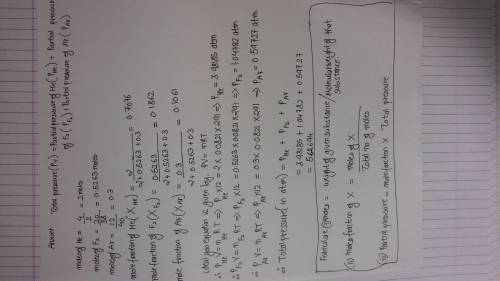
Chemistry, 18.09.2019 07:50, javonteoshamccaliste
4.00 g of he, 20.0 g f2, and 12.0 g ar are placed in a 12.0-l container at 18.0 °c. the total pressure (in atm) in the container is atm.

Answers: 1
Other questions on the subject: Chemistry

Chemistry, 22.06.2019 04:30, logan12345677885675
What are the primary responsibilities of a chemical engineer involved in "r& d"? develop large scale manufacturing operations discover new products and processes training of new chemists determine products needed by consumers
Answers: 2

Chemistry, 22.06.2019 23:30, znewkirk4741
Imagine a small synthetic vesicle made from pure phospholipids enclosing an interior lumen containing 1 mm glucose and 1 mm sodium chloride. if the vesicle is placed in pure water, which of the following happens faster? a. na+ diffuses out. b. cl– diffuses out. c. h2o diffuses in. d. glucose diffuses out. e. sodium chloride diffuses out.
Answers: 3

Chemistry, 23.06.2019 02:50, agm0102
What is the typical rotational frequency frot for a molecule like n2 at room temperature (25∘c)? assume that d for this molecule is 1å=10−10m. take the total mass of an n2 molecule to be mn2=4.65×10−26kg. you will need to account for rotations around two axes (not just one) to find the correct frequency. express frot numerically in hertz, to three significant figures.
Answers: 3

Chemistry, 23.06.2019 09:00, blossie94681
The vapor pressure of water at 25.0°c is 23.8 torr. determine the mass of glucose (molar mass = 180 g/mol) needed to add to 500.0 g of water to change the vapor pressure to 22.8 torr.
Answers: 1
Do you know the correct answer?
4.00 g of he, 20.0 g f2, and 12.0 g ar are placed in a 12.0-l container at 18.0 °c. the total pressu...
Questions in other subjects:



Mathematics, 13.11.2020 21:50

History, 13.11.2020 21:50


Mathematics, 13.11.2020 21:50

Mathematics, 13.11.2020 21:50









